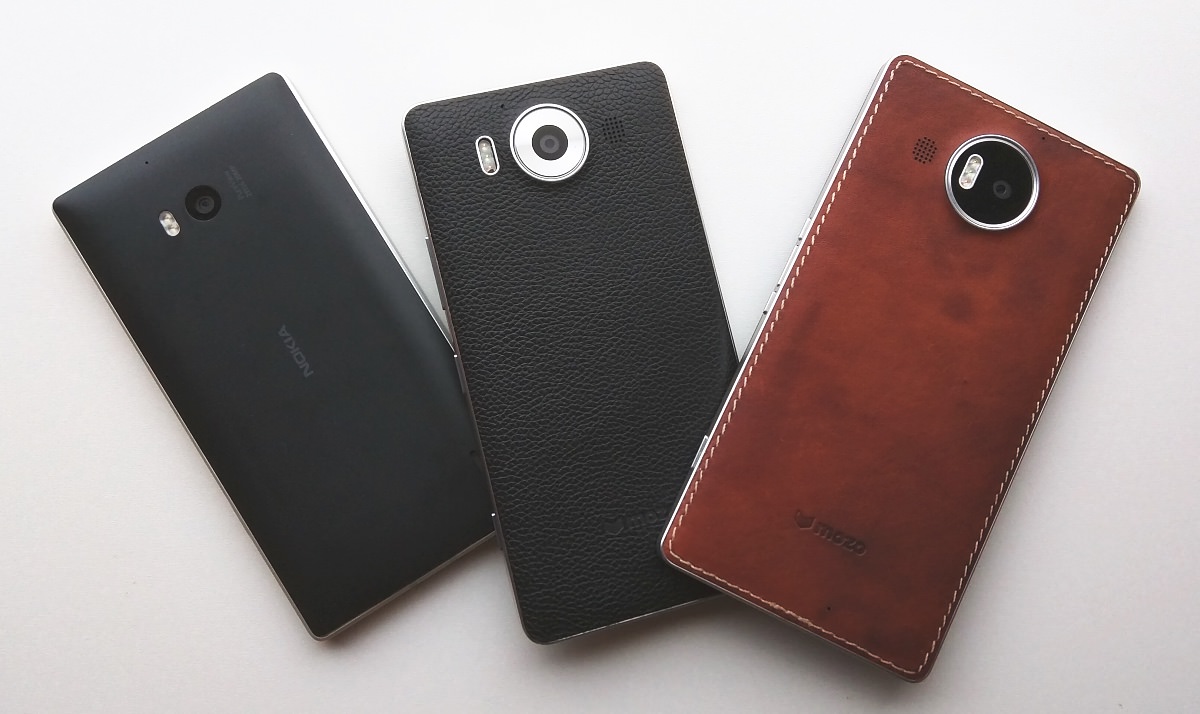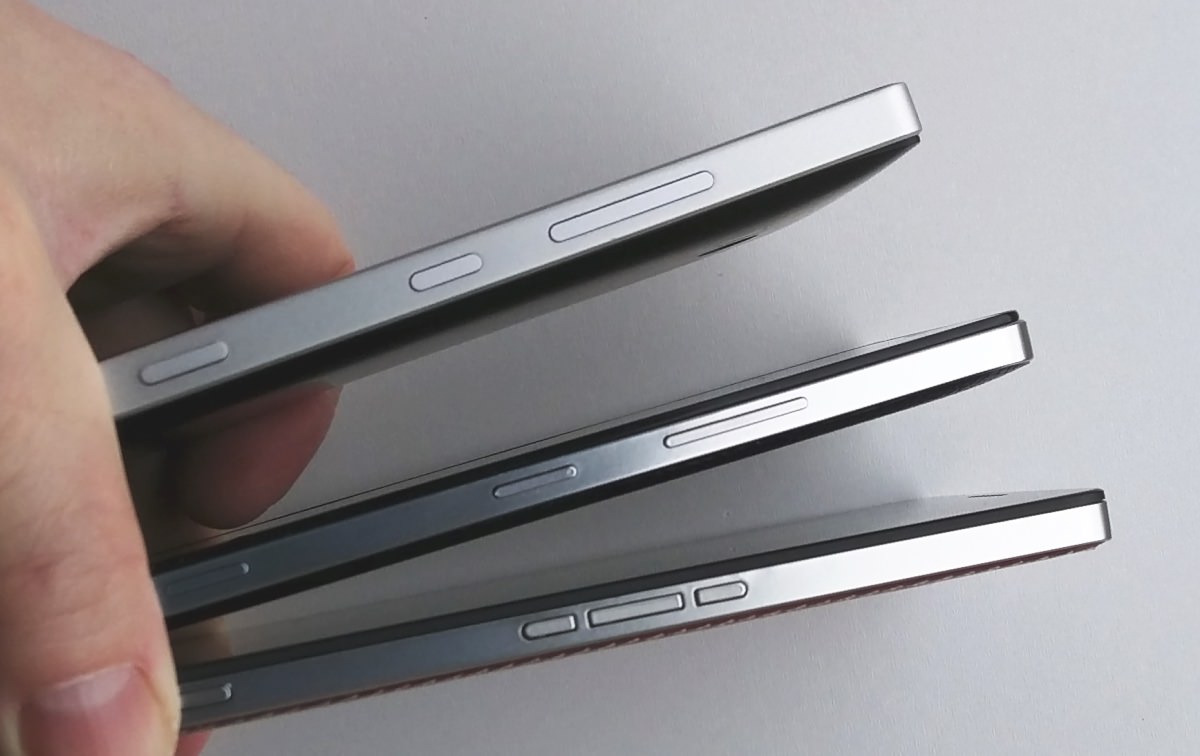Writer's note: this article does borrow from the previous article, naturally, but there are new benchmarks and observations throughout, spurred on by all three phones now effectively running a very different OS - Windows 10 Mobile has come a long way!
_____________________

Before anyone points out that the Lumia 950 range runs Windows 10 Mobile and the old Lumia 930 runs 'ye olde' Windows Phone 8.1, I'm of course talking about the 930 on the exact same OS build, under the Insiders Programme, in this case Redstone 2, the 149xx builds, which will eventually surface in the production world as the 'Creators Update' (not that there's that much creating going on (apart from imaging) in the mobile world - yet, without the Surface pen and dial...) So a genuinely level playing field.
Starting with a specification rundown with comments (the table in the original article contained some minor errors since the 950 range was so new at that point!), I've added on a second table with some benchmarks too:
| Lumia 930/Icon | Lumia 950 | Lumia 950 XL | |
| Materials/Design | VERY solid aluminium chassis fixed plastic back plate |
Plastic chassis plastic back/sides come off |
Plastic chassis plastic back/sides come off |
| Dimensions | 137 x 71 x 10mm, 167g | 145 x 73 x 8mm, 150g | 152 x 78 x 8mm, 165g |
| Chipset | 2.2GHz Snapdragon 800 | 1.8GHz Snapdragon 808 64-bit hexacore |
2.0GHz Snapdragon 810 64-bit octacore 'Liquid cooling' |
| GPU | Adreno 330 | Adreno 418 | Adreno 430 |
| Connectivity | LTE | LTE plus dual SIM option | LTE plus dual SIM option |
| RAM | 2GB | 3GB | 3GB |
| Controls | Physical, capacitive | Virtual, on-screen | Virtual, on-screen |
| Display | 2.5D glass (curved to device edges) 5" AMOLED, 1080p ClearBlack Display Gorilla Glass 3 |
5.2" AMOLED, QHD (1440p) ClearBlack Display Glance screen Gorilla Glass 3 |
5.7" AMOLED QHD (1440p) ClearBlack Display Glance screen Gorilla Glass 4 |
| Storage | 32GB | 32GB, plus microSD | 32GB, plus microSD |
| Rear camera | 20MP, PureView oversampling 1/2.5", f/2.4 Third generation OIS Dual LED flash 4K capture Rich Recording audio Dedicated capture key |
20MP, PureView oversampling 1/2.4", f/1.9 Fifth generation OIS Triple LED flash 4K capture Rich Recording audio Dedicated capture key |
20MP, PureView oversampling 1/2.4", f/1.9 Fifth generation OIS Triple LED flash 4K capture Rich Recording audio Dedicated capture key |
| Front camera | 1.2MP | 5MP | 5MP |
| Cabling/charging | microUSB Qi wireless |
USB Type-C (up to 5Gb/s) Power Delivery (up to 3A) Qi wireless |
USB Type-C (up to 5Gb/s) |
| Battery | 2420mAh sealed | 3000mAh replaceable | 3300mAh replaceable |
| Speaker | Rear-mounted mono, decent EQ by default |
Rear-mounted mono, a bit tinny |
Rear-mounted mono, a bit tinny |
| Other | FM Tuner | Infrared iris-scanner biometrics Continuum-ready |
FM Tuner Infrared iris-scanner biometrics Continuum-ready |
And now for some ad-hoc real world benchmarks with this latest branch of Windows 10 Mobile:
| Benchmark times under Redstone 2 (via Insiders) |
Lumia 930/Icon | Lumia 950 | Lumia 950 XL |
| Boot to Start screen |
40s | 39s | 37s |
| Launch Cortana to news/weather |
6s | 6s | 6s |
| Launch Outlook Mail | 2s | 2s | 2s |
| Launch Store | 6s | 6s | 4s |
| Launch Skype | 3s | 2.5s | 2s |
| Launch Weather to b/g animation |
6s | 6s | 6s |
| Launch Perfect Tube to filled in Subs |
8s | 8s | 11s |
My gut feel using the Lumia 930 is that it's just as fast as the two much newer handsets (which are faster but have more pixels to push around) and the timings bear this out - the experience is effectively identical. The only minor differences above are on the 950 XL in a couple of places and this is probably down to the latter being on the Fast RS2 ring and not the Slow one, hence a very slightly different build.
As in my original article, and in the light of the Lumia 950 range having been widely criticised for some of the hardware decisions by Nokia/Microsoft, it's instructive to look at the more elderly Lumia 930's hardware again. (The 950 range is also no longer produced, so whichever way you approach the comparison, they're not that available brand new and so are on a very level playing field with older phones.)
The Lumia 930's hardware, two years on
Design, materials. Switching between the 930 and the 950/XL, the difference in the hand is astonishing. Yes, the 950 and 950 XL can have a Mozo case fitted to give that metallic look, but they both still feel like plastic and relatively insubstantial in the hand. The leather makes up a little for all this, but when I pick up the 930 again afterwards, it's very evident that the solid metal chassis (not to mention the sumptuous 2.5D front glass) is the real thing. In contrast, the Lumia 950 range feel too light - this seems like a strange thing to complain about and, in truth, it's not really a complaint. More that I like a little weight in my smartphone, a feeling that there's substantial tech inside and that it's going to last a long time.
Speaker. The 930 definitely has the better speaker, by a country mile. I'm a big fan of speakers which are good enough that I don't need to carry around a Bluetooth speaker in order to listen to podcasts around the house - or to have to resort to headphones all the time. I've done numerous blind tests and others have said the 930's audio was noticeably fuller and higher quality, even after the 950 and 950 XL speakers have been EQ tuned.
microUSB. Admittedly our tech world is gradually converting from microUSB to USB Type C, but we're nowhere near at the tipping point yet. The use of microUSB on the Lumia 930 means that wherever you go in the world, you'll find a cable, an emergency charger, an adapter to fit the 930, whereas I usually have to carry around the 950 and 950 XL with their own Type C cables (and both of them, A-to-C and C-to-C), just in case I want to plug into something.
Size. The Lumia 930 is significantly smaller than the 950, the extra few millimetres of width and the half a centimetre in height make the 950 bigger than it needs to be (relative to usable screen size most of the time). Whereas there's hardly a millimetre wasted on the Lumia 930, thanks to the use of capacitive controls - the 950's display is larger, but with the virtual controls up it's significantly smaller than the 930's true 5". In fairness, it's easy to hide the controls on the 950 if needed, temporarily, and in some applications (e.g. Photos), they auto-hide when something's being shown anyway.
No virtual controls to burn in. One issue on the newer 950 models is that the usually visible navigation bar/controls accelerate AMOLED screen 'burn in', with the Windows logo ghosted on top of areas of solid colour in other applications. AMOLED displays do 'burn in', though in the past it's only been parts of the small status bar at the top on the likes of the 1020 and 925. The Lumia 950 and 950 XL mark the first time AMOLED's been used for a virtual navigation bar and, unsurprisingly, that semi-permanent big Windows 'Start' logo is going to degrade the pixels. I'm really not sure Microsoft thought about this at the design stage. In fairness, there's negligible burn-in on my editorial 950 and 950 XL after a year, but then I've been swapping phones often so haven't had more than a couple of months solid use on either. Data points welcomed.

The higher specced 950 range
But, of course, we then come on to the newer specifications of the Lumia 950 and 950 XL. Faster processors, more RAM, faster GPUs, higher resolution displays, more sensitive cameras, brighter LED flash, higher capacity batteries, biometric authentication, microSD support, and so on. However much more premium the 930 felt in the hand, however better the speaker sounded, you can't ignore the higher specs right across the board, surely?
Probably not, though as I showed above, in daily use the 950 and 950 XL are only slightly faster with Windows 10 Mobile Redstone 2 than the Lumia 930 (and the 1520 before it), so speed is absolutely not an issue.
What about the displays then? QHD resolution has got to impress, right? Well, it does - though 1080p (at 5" on the Lumia 930 - and in fact the full RGB stripe 6" LCD on the older Lumia 1520) also still impresses, my eyes simply can't tell the difference, looking at the same photo on the 930 and 950. You do get Glance screen on the newer phones, mind you, and even Nokia admitted after the fact that they'd made a mistake in not specifying the Lumia 930 with display memory (i.e. to enable Glance).
The cameras? Ah, now here's a big difference, as I showed in my imaging head to head here. The camera capabilities and intelligence on the 950 and 950 XL remain unsurpassed, despite all of my camera head-to-head tests through 2016 from the industry's challengers. The 950/XL remains the premier camera phone in the world at the moment, on any platform, in my opinion, though I agree the gap to the competition is much smaller than it used to be.
microSD support might be huge for some people - and goodness knows, I'm a fan, though in fairness I always seem to manage with 32GB phones like the 930 and 1020, so it really depends how much media you need to carry around with you - I'll admit that there's a certain reassurance in knowing I can take all my music with me, on card, rather than the handful of albums I have to allow myself on the 32GB 'sealed' devices.
Biometrics are a sore point - the iris recognition on the Lumia 950 and 950 XL is still sufficiently slow that you might as well bash in a PIN instead, as you're forced to on the older Lumia 930. And, at this point, I don't think Microsoft are going to speed it up in software. The replaceable-back-shell and all-screen front design was the main driver behind not including a fingerprint scanner, but in today's world of late 2016 where the norm is an instant-on fingerprint sensor, the 950 and 950 XL look somewhat off to one side in the grand scheme of things.
Finally, there's Continuum, pitched as a huge unique selling point - and rightly so, it's a potentially huge differentiator. Except that it's only partly built - there's so much more software to write before the smartphone really can provide a genuine desktop-like experience when docked or connected. Plus the only real game changer in this area, the 950-compatible HP Lapdock is a) late and b) massively overpriced.

Verdict
The takeaway from all this should be that if you own a Lumia 930 (or 1520) and are happy with the size, storage, camera and battery life under Windows 10 Mobile, then there's not that much to be gained overall (and, as I argued above, some things to lose) by switching to the Lumia 950 and 950 XL. The latter in out in camera and overall flexibility, but I still find my heart skipping a beat when I pick up the super-solid metai chassis of the Lumia 930 all over again. It's not a perfect device, it never was, but it's a darned good smartphone with Redstone 2 under the bonnet.
